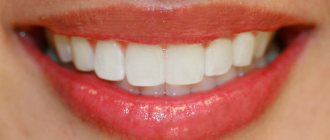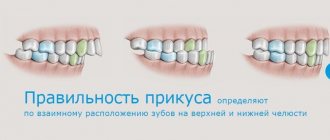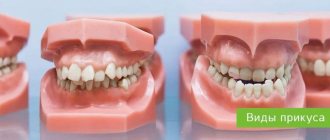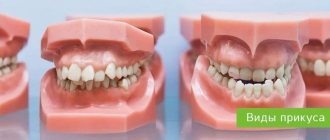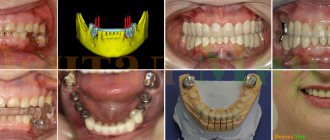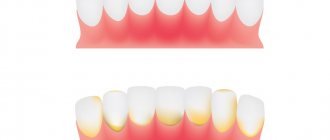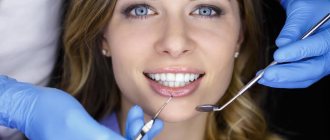It is difficult to find a person who does not dream of maintaining healthy, strong teeth until old age. After all, healthy white teeth mean a beautiful smile in the photo, self-confidence, and absence of pain. Healthy teeth are also a good help in the proper functioning of many systems of our body.
Doctors say that healthy, strong teeth are always a pressing issue in dentistry. In fact, all their activities are aimed at keeping people’s teeth healthy.
And in the same way, in order for healthy white teeth to delight us in old age, we need to take care of them all our lives, using all means of disease prevention, including folk ones.
Signs of correct teeth bite
To understand what a person’s correct bite should be, you need to know about several types of teeth arrangement that are considered normal. These include:
- 1. Orthognathic. The top row overlaps the bottom row by 30%.
- 2. Opisthognathic. The teeth are slightly inclined towards the oral cavity.
- 3. Direct. The cutting edges of the upper teeth touch the cutting edges of the lower teeth.
- 4. Biprognathic. The teeth are slightly directed towards the vestibule of the mouth.
- 5. Progenic. The lower dentition is slightly pushed forward.
If any of the listed types of normal occlusion are detected, correction is not required. This arrangement does not lead to negative consequences and does not affect a person’s appearance.
Getting started on your perfect smile: healthy teeth
A Hollywood smile means, first of all, absolutely healthy teeth. Therefore, at the first stage, the doctor examines the oral cavity and prescribes the necessary additional examinations. After this, you will be prescribed dental treatment.
When teeth are severely damaged, conventional filling is not always advisable and it would be more correct to make a restoration with a crown:
- If the tooth is severely damaged, even a high-quality filling will not last long. It destroys itself and affects nearby tooth tissues and the root. An attempt to fill such teeth may lead to the need for extraction and prosthetics.
- Filling materials darken over time. External factors and bad habits, such as smoking, can change the color of a tooth filling. On the front teeth, the dark filling stands out strongly. As a result, a smile, into which a lot of effort and time has been invested, ceases to be beautiful.
Modern dental crowns are visually indistinguishable from your own teeth. Everything corresponds to an ideal smile - shape, size, shade.
We recommend using ceramic crowns to restore the smile area. Why ceramics:
- Aesthetics. In a Hollywood smile, the crown should not stand out against the background of the teeth, and this can only be achieved if the material used matches the tooth enamel in color and transparency. Dental ceramics remain the best choice for these indicators.
- Strength. Teeth crowns used in the smile area do not require the same strength as molar dentures. But at the same time, the crown must be able to withstand the load while eating. Otherwise, the artificial tooth will simply collapse.
- Biocompatibility. Dental ceramics are biocompatible, so they do not cause allergies, and galvanic currents do not occur while wearing crowns. Biocompatibility is important to create the perfect smile. Patients with ceramic crowns do not experience problems such as cyanosis or swelling of the gums, or discoloration of the gingival margin. The teeth and gum edges are beautiful.
A mandatory step in creating an ideal smile is professional oral hygiene. Plaque, soft dental deposits, and stone are removed from the surface of the teeth. They shouldn't be on beautiful teeth.
Malocclusions
If the position of the teeth does not correspond to any of the options listed above, then a malocclusion should be suspected. There are several types of pathological bite:
- 1. Open. In the anterior or lateral areas of the dentition, when closing, the teeth do not touch each other.
- 2. Prognathic (distal). The upper row protrudes above the lower due to underdevelopment of the lower jaw or excessive growth of the upper.
- 3. Deep. The top row overlaps the bottom row by more than 50%.
- 4. Mesial. The lower dentition overlaps the upper due to excessive growth of the lower jaw or insufficient development of the upper.
- 5. Cross. The teeth intersect in one or more zones like scissors. Can be bilateral or unilateral.
- 6. Reducing. Occurs in the absence or pathological wear of teeth.
Knowing what is a normal dental bite and what is considered an anomaly is necessary for timely consultation with a doctor and correction.
How to find out what kind of bite you have
Patients are often interested in how to determine whether their bite is correct. Usually the presence of abnormalities can be identified by facial features. It is also worth taking into account the criteria for correct bite described above. Go to the mirror, open your mouth and clench your teeth. In some cases, violations are immediately visible. Just because your smile looks aesthetically pleasing does not guarantee that everything is fine.
Even if you know what a correct bite should look like, it is impossible to make a correct diagnosis on your own. Only a specialist can do this. In addition to a visual examination and medical history, the doctor diagnoses the problem based on the results of a CT scan (computed tomography). Such an examination allows you to comprehensively assess the condition of the oral cavity. Disturbances in the placement of teeth are also identified by an impression made from an alginate mass. The orthodontist also needs photographs of the person’s face taken from several angles. Using them, you can evaluate the occlusal relationships of the dentition.
Reasons for the development of malocclusion
The reasons for the violation of the correct position of teeth can be either congenital or acquired. The main risk factors for the formation of malocclusions:
- – genetic predisposition;
- – improper breastfeeding or bottle use;
- – sucking on pacifiers, fingers or other objects in infancy;
- – congenital developmental anomalies;
- – mouth breathing for diseases of the respiratory system;
- – lack of sufficient solid food in children’s diets according to their age;
- – premature or delayed change of baby teeth;
- – lack of calcium and/or fluorine in the body;
- – trauma to the dentofacial apparatus;
- – severe caries with destruction and loss of teeth;
- – lack of space on the jaw for cutting figure eights;
- – incorrectly installed or unsuitable dentures in adults.
Regardless of the reasons, each patient needs bite correction to restore the functionality of the dentofacial apparatus.
What is anterior tooth restoration?
Restoration of anterior teeth is an opportunity to restore damaged teeth and restore aesthetic appeal to a smile.
The goal of the procedure is not only to restore the appearance of the dentition, but also its physiological functions. That is, reconstruction also has a health-improving task. This procedure should not be confused with a simple filling. Restoration involves replenishing the volume and integrity of the crown. For this purpose, composite materials are used, with the help of which the dentist-therapist recreates the destroyed dental unit layer by layer. Artistic restoration is not a treatment, but a correction. It helps correct various defects and return dental units to a physiologically normal position, as well as a healthy appearance. Indications for restoration are:
- pathological change in the size and shape of dental units;
- chips, cracks, other defects;
- abrasion of dental tissue;
- carious lesion.
However, patients cannot always undergo restorative procedures. For example, in the presence of bruxism, malocclusion, allergic reactions to composites or other materials, reconstruction is contraindicated. Therefore, the patient first undergoes mandatory diagnostics. At Denta-Professional you can sign up for a free consultation to ask all your questions to the dentist and undergo an examination. Call.
Ways to correct a bite
Treatment of pathological occlusion is prescribed by an orthodontic doctor. You need to contact him as early as possible, since it is much easier to restore the normal position of teeth in childhood. The correction method depends on the age, type of pathology, and individual characteristics of the patient.
The following types of treatment are used:
- 1. Trainers, orthodontic plates and other devices for children. They allow you to set the correct growth of teeth, promote adequate development of the jaws and muscle frame.
- 2. Bracket systems. Fixed structures that are used only for permanent teeth. Helps move teeth in the right direction.
- 3. Aligners. Removable structures, which are transparent mouth guards. Bite correction occurs by gently shifting teeth when changing from one set of trays to another.
- 4. Surgical treatment. It is used when there is no effectiveness from conservative methods.
Our clinic uses only proven bite correction technologies. Doctors use high-quality and durable braces, aligners from well-known manufacturers, comfortable trainers and other devices.
How much does a Hollywood smile cost?
It is impossible to answer definitively the question of how much it will cost to create a Hollywood smile. It all depends on the source data. Doctors of different specialties often participate in the work - therapists, hygienists, orthodontists, orthopedists, implantologists. The better the condition of your teeth and oral cavity, the cheaper a perfect smile will cost. In rare cases, all procedures end with professional hygiene and whitening.
Additional treatment always increases costs. The final cost of a beautiful smile is determined by several factors:
- Type of treatment;
- Volume of medical procedures;
- Technologies used;
- Types of orthopedic and orthodontic structures used, etc.
To find out the exact cost of your new smile, come for a consultation with a dentist at our clinic. If necessary, the doctor will refer you for examination and consultation with specialized specialists. After this, we will be able to calculate the prices of all procedures necessary to create a Hollywood smile.
An example of a bite corrected with braces - photo
Composite veneers
Installing veneers made of composites has certain disadvantages.
You can study reviews from patients who have already visited the dentist for this service. This will help you evaluate whether these veneers are right for you. We have collected information from specialists who work in the best dentistry in the country. They note that in the vast majority of cases, dentists create composite veneers directly during a session directly in the visitor’s mouth. This turns veneers into reinforced restoration fillings. The filling is distributed over the front surface of the tooth, but its cost is an order of magnitude higher than a traditional restoration. This technology has nothing in common with classic veneers and is unable to perform their functions. The production of high-quality composite veneers is carried out outside of dentistry - in the laboratory of a dental technician.
The task of dentists is to grind down the teeth to cover them with veneers and take reliable impressions of them. The impressions must be sent to the dentist. The specialist creates a veneer on a light composite, providing it with the necessary qualities. Such veneers acquire high performance properties, but their characteristics cannot be compared with porcelain and zirconium analogues.
Composite veneers: reviews from dentists
Tooth restoration with a composite veneer. Photos before and after
Considering modern composite veneers, one can note their modest aesthetic qualities. Such a coating is not capable of achieving the performance of ceramic veneers. Most patients encounter a problem when a visit to the dentist ends with the fixation of a veneer that does not match the rest of the teeth. Composite compositions are difficult to adapt to the characteristics of natural teeth.
Color stability of composite veneers
Among the indicators of composite veneers, the level of color stability ranks last. During use, such veneers gradually begin to lose their brightness and color. Varieties of ceramic veneers are not susceptible to this, since this material does not change color shade and translucency throughout the entire period of operation.
Strength of materials
Veneers made of composite material are more fragile than ceramic type veneers. Their reliability is incomparable to that of veneers made from zirconium compounds, which have unsurpassed strength. Due to their high fragility, such veneers are installed with the obligatory overlap of the cutting edge of the tooth. This means that you will no longer bite food with your own tooth, but with the veneer.
Manufacturing technology of composite veneers
Dental professionals face quite a difficult task. They need to create a high-quality veneer in your mouth. Achieving the goal is hampered not only by limited time, but also by high humidity and the presence of only artificial lighting. The desired color shade of the veneer can be achieved only by gradual layer-by-layer application of the filling composition. The required shade of veneer is selected for each layer. Creating high-quality veneers in laboratories takes longer and is much more expensive. As for their characteristics, these veneers will significantly surpass in their qualities analogues created in dentistry itself.
How to install veneers
The creation of veneers is carried out in several successive stages. First, the dental employee prepares the teeth. If outdated composite fillings are installed on the surface of the tooth or the patient used braces, they are removed. Old fillings are replaced with new ones if the procedure involves preserving the base of the filling after the preparation is completed. This not only improves the aesthetics of the veneer, but also improves adhesion between surfaces.
The second stage of work includes choosing the color shade of the veneers. For this purpose, special scales of shades and colors are used. They are standard and present in any dentistry in Moscow. In addition to tools, the specialist focuses on the client’s personal wishes.
Next, they begin to prepare the teeth. Installation of veneers is carried out after grinding down about 0.5 - 0.7 mm of the natural tooth enamel located on its front surface. At the same time, the installed fillings are polished. The exact size of the enamel layer to be polished is determined individually in dentistry.
The fourth step is making dental impressions. Impressions can be made after the teeth have been prepared. They are sent to a dental technology laboratory operating in dentistry. During the period of production of permanent veneers, the patient is given a temporary alternative. Temporary veneer is designed to protect the patient’s exposed teeth from aggressive environments and food contact with their surface. As part of the laboratory stage, accurate plaster models of the client’s teeth are made. They are necessary to create the most accurate veneers from ceramic or zirconium alloy.
This example shows the stages of placing veneers. Photos before and after
At the final stage, the veneers are fixed using special pastes of two different colors. The color of the cement is matched to the color of the dental client’s enamel, as this determines the final shade of the finished veneer. The dentist’s task is to give the veneer a tone that is as close as possible to the color of the adjacent teeth. The desired shade can be achieved by alternating two shades of fixing pastes. A permanent veneer is glued onto the prepared base.
While in dentistry, you can conduct a dialogue with a specialist and tell him about your claims regarding the quality of the veneer, its color or shape. From the moment the veneer is secured with permanent cement, nothing can be changed. It is easier to remove braces than to adjust permanent veneers.
Conclusion
Everyone should know what the correct bite is in a person in order to respond to the problem in a timely manner. Ignoring the situation leads to many unpleasant consequences, for example, impaired diction, pathological abrasion of enamel, impaired facial symmetry, dysfunction of the temporomandibular joint and others.
When correcting your bite, you must strictly adhere to the orthodontist's recommendations. Failure to comply with prescriptions and interruption of treatment not only slows down the restoration of the bite, but can also aggravate the situation. Make an appointment at Leonid Gorbunov's orthodontic studio to check your bite and make an effective correction.
Posted by:
"Denta-Professional" - high-quality restoration of anterior teeth
Our clinic has been operating for over 20 years. Every year we help hundreds of patients achieve a beautiful smile. Our dentistry offers:
- Professionalism. We employ only highly qualified doctors who regularly undergo advanced training courses and master new working methods.
- Safety. We carefully comply with all existing sanitary standards to provide our patients with the best conditions. All reusable instruments are disinfected, and disposable ones are disposed of after use.
- Individual approach. We select the course of treatment, the necessary materials, and anesthesia based on the physiological characteristics of the patient. It is important to us that any procedure is not only successful, but also effective.
- Guarantees. We provide a guarantee of up to 5 years for the work we perform. If during the warranty period anything happens to the installed fillings or other materials, we will repeat the procedure free of charge.
Sign up for a consultation now.
